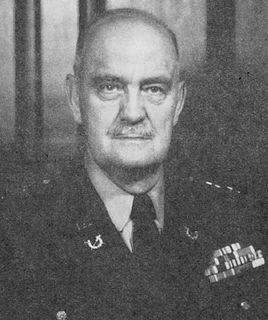
The 13th Division was an infantry division of the United States Army. It was established at Camp Lewis, Washington, in 1918, during World War I. [1] The war ended before the division saw combat, and it was inactivated in 1919. [2]

The 13th Division was an infantry division of the United States Army. It was established at Camp Lewis, Washington, in 1918, during World War I. [1] The war ended before the division saw combat, and it was inactivated in 1919. [2]
The 13th Division was activated at Camp Lewis, Washington on July 16, 1918 as part of the U.S. military mobilization for World War I. [2] It was manned and trained at Camp Lewis in preparation for combat in France, and formed from a few existing units as the organization's nucleus, while draftees, predominantly from the West Coast of the United States, filled out the majority of the division. [2]
The "square" 13th Division's complement of four regiments included the 1st, 44th, 75th, and 76th Infantry Regiments. [2] In August 1918, the regiments were organized to form two brigades—the 25th (1st and 75th Regiments, plus the 38th Machine Gun Battalion) -- and the 26th Brigade (44th and 76th Regiments, plus the 39th Machine Gun Battalion). [2]
Cornelius Vanderbilt III served as the division's interim commander in the summer of 1918. [2] As they had for the recently departed 91st Division, community leaders welcomed Vanderbilt at a formal reception which took place at the newly-constructed Camp Lewis gymnasium, and included an orchestra, and more than 1,000 guests, including Governor Ernest Lister. [2] In addition to the reception for Vanderbilt, the civilian community welcomed the 13th Division's soldiers with public events, including a picnic and a track meet. [2]
Horace R. Cayton Sr., the publisher of Cayton's Weekly and Seattle's first African American journalist, criticized Vanderbilt for barring black troops from Camp Lewis's most popular recreation center. [2] He had also segregated the camp's Young Women's Christian Association (YWCA) Hostess House, which was widely popular among soldiers. [2] Vanderbilt lifted the bans in September as the result of the public outcry generated by Cayton's articles. [2]
The 13 Division was briefly commanded by Brigadier General Frank B. Watson, with Vanderbilt taking command of the 25th Brigade. [2] When the permanent commander, Major General Joseph D. Leitch arrived in October 1918, Watson assumed command of the 26th Brigade. [2]
In late September 1918, the Spanish influenza epidemic reached Camp Lewis, and the post soon averaged 10 deaths per week. [2] In early October, the 213th Engineer Regiment arrived for assignment to the 13th Division, and brought even more ill soldiers into the camp. [2] In an effort to halt the widening epidemic, Leitch imposed a quarantine on October 19. [2]
A Tacoma Daily Ledger fundraising campaign to erect the world's largest flagpole at Camp Lewis culminated on October 12, 1918, when soldiers attempted to raise a 60-by-90-foot American flag which was mounted on a 314-foot-tall pole made from a Douglas fir tree. [2] The event was sparsely attended because of the flu quarantine, and soon after the pole went up, a gust of wind whipped the flag hard enough to snap the pole in three places. [2] An attempt to raise a 214-foot pole in November also met with failure, as the wind caught the flag during the dedication ceremony, snapped the pole into two pieces and shredded the flag. [2] A third, more traditional flagpole was successfully erected later in November. [2]
Major Alexander P. Cronkhite was a company commander in the 213th Engineers and the son of Major General Adelbert Cronkhite. [2] He arrived at Camp Lewis in early October, and was soon hospitalized with influenza. [2] Major Cronkhite was released on October 21, and joined his company for a cross-country hike. [2] Because he was still recovering, another officer was temporarily in command. [2] When the group stopped to rest and eat lunch, Cronkhite used a borrowed handgun to engage in target practice by shooting at a tobacco tin on a nearby fence post. [2] While engaged in this activity, Cronkhite sustained a gunshot wound and died at the scene. [2] Subsequent investigation found that it was accidental and self-inflicted. [2]
Adelbert Cronkhite did not accept this finding, and pushed for several years to have the investigation reopened. [2] In the mid-1920s, the sergeant and captain who had been with Alexander Cronkhite when he died were arrested and charged with murder. [2] Because the captain was Jewish, Adelbert Cronkhite's cause was taken up by anti-Semitic newspapers, creating a nationwide story. [2] When the sergeant was tried, defense attorneys were able to demonstrate that an accidental shooting was the most likely possibility. [2] He was acquitted, and charges against the captain were soon dismissed. [2]
The armistice of November 11, 1918 ended World War I before the 13th Division could complete its training and depart for France. [2] Within a few days, Leitch began permitting the release of officers who were no longer needed, as well as soldiers who requested discharge so they could return home to support their families. [2] The 13th Division held a demobilization parade on November 22, 1918, with members of the local community watching primarily from their automobiles as a precaution against the spread of influenza. [2]
The division was nearly demobilized by February 1919, except for the 13th Field Artillery Brigade, which was briefly employed in Seattle to help restore order during a labor strike. [2] Demobilization resumed again on February 25, and the soldiers of the 13th Field Artillery Brigade were soon discharged to civilian life. [2]
The 13th Division's shoulder sleeve insignia was approved by the War Department shortly before the division demobilized. [2] It consisted of a blue circle featuring the number 13 in white. [2] A black cat depicted above a red horseshoe open at the top were intended to represent hoodoo that the Germans could not defeat, and the good luck that the division expected to have during combat in France. [2]

The 2nd Infantry Division is a formation of the United States Army. Its current primary mission is the pre-emptive defense of South Korea in the event of an invasion from North Korea. There are approximately 17,000 soldiers in the 2nd Infantry Division, with 10,000 of them stationed in South Korea, accounting for about 35% of the United States Forces Korea personnel.

The 5th Infantry Division (Mechanized)—nicknamed the "Red Diamond", or the "Red Devils" —was an infantry division of the United States Army that served in World War I, World War II and the Vietnam War, and with NATO and the U.S. Army III Corps. It was inactivated on 24 November 1992 and reflagged as the 2nd Armored Division.

The 35th Infantry Division, formerly known as the 35th Division, is an infantry formation of the Army National Guard at Fort Leavenworth.

The 8th Infantry Division, ("Pathfinder") was an infantry division of the United States Army during the 20th century. The division served in World War I, World War II, and Operation Desert Storm. Initially activated in January 1918, the unit did not see combat during World War I and returned to the United States. Activated again on 1 July 1940 as part of the build-up of military forces prior to the United States' entry into World War II, the division saw extensive action in the European Theatre of Operations. Following World War II, the division was moved to West Germany, where it remained stationed at the Rose Barracks in Bad Kreuznach until it was inactivated on 17 January 1992.

The 80th Training Command is a formation of the United States Army Reserve.

The 77th Sustainment Brigade is a unit of the United States Army that inherited the lineage of the 77th Infantry Division, which served in World War I and World War II. Its headquarters has been at Fort Dix, New Jersey, since its predecessor command, the 77th Regional Readiness Command, was disestablished in 2008 from Fort Totten, in Bayside (Queens), New York. Soldiers from the 77th have served in most major conflict and contingency operations since World War II.

The 92nd Infantry Division was an African-American infantry division of the United States Army that served in both World War I and World War II. The military was then segregated. The division was organized in October 1917, after the U.S. entry into World War I, at Camp Funston, Kansas, with African-American soldiers from all states. In 1918, before leaving for France, the American buffalo was selected as the divisional insignia due to the "Buffalo Soldiers" nickname, given to African-American cavalrymen in the 19th century. The divisional nickname, "Buffalo Soldiers Division", was inherited from the 366th Infantry, one of the first units organized in the division.

The 97th Infantry Division was a unit of the United States Army in World War I and World War II. Nicknamed the "Trident division" because of its shoulder patch, a vertical trident in white on a blue background, it was originally trained in amphibious assaults as preparation for deployment in the Pacific Theater. It was deployed to Europe in 1944 when casualties from the Battle of the Bulge needed to be replaced.

The 42nd Infantry Division (42ID) ("Rainbow") is a division of the United States Army National Guard. The 42nd Infantry Division has served in World War I, World War II and the Global War on Terrorism (GWOT). The division is currently headquartered at the Glenmore Road Armory in Troy, New York.

The 37th Infantry Division was a unit of the United States Army in World War I and World War II. It was a National Guard division from Ohio, nicknamed the "Buckeye Division". Today, its lineage is continued through the 37th Infantry Brigade Combat Team, with battalions from Ohio, Michigan, and South Carolina.

The 30th Infantry Division was a unit of the Army National Guard in World War I and World War II. It was nicknamed the "Old Hickory" division, in honor of President Andrew Jackson. The Germans nicknamed this division "Roosevelt's SS". The 30th Infantry Division was regarded by a team of historians led by S.L.A. Marshall as the number one American infantry division in the European Theater of Operations (ETO), involved in 282 days of intense combat over a period from June 1944 through April 1945. In the present day the 30th Armored Brigade Combat Team is now a part of the North Carolina National Guard and their most recent combat deployment was in 2019.

The 31st Infantry Division ("Dixie") was an infantry division of the United States Army National Guard, active almost continuously from 1917 to 1968. Composed of men from Alabama, Florida, Georgia, Louisiana, Michigan, Illinois, and Mississippi at various points in its existence, the division saw service in both World War I and World War II, and was mobilized during the Korean War, although it was not sent overseas in the latter.

The 27th Infantry Division was a unit of the Army National Guard in World War I and World War II. The division traces its history from the New York Division, formed originally in 1908. The 6th Division designation was changed to the 27th Division in July 1917.

The Panama Canal Division was a unit of the United States Army, established in order to ensure the United States could adequately defend the Canal Zone in Panama. When it was authorized in 1920, similar divisions were organized to defend Hawaii and the Philippines.

The 39th Infantry Division was an infantry formation of the Army National Guard, originally formed as the 18th Division in 1917. The division consisted of troops from Arkansas, Louisiana, and Mississippi. After training at Camp Beauregard, Louisiana, the division was deployed to France but did not see combat before the end of World War I. In July 1923 the division was re-designated as the 31st Infantry Division. The 39th Infantry Division was reactivated after World War II with troops from Louisiana and Arkansas and its headquarters in Louisiana. In 1967, the 39th Infantry Division was reorganized to become the 39th Infantry Brigade (Separate). Its headquarters was in Little Rock and the unit consisted entirely of troops from Arkansas.
The 226th Infantry Brigade was a Home Service formation of the British Army that existed under various short-lived titles in both the First and Second World Wars.
71st Division was a short-lived infantry division of the British Army during the First World War. It served in the Home Defence forces and never went overseas.
The 82nd Airborne Division Artillery (DIVARTY) is the divisional artillery command for the 82nd Airborne Division of the United States Army, stationed at Fort Bragg, North Carolina. It was organized in 1917, during World War I, was inactivated in 2006 as part of the transformation to modular brigade combat teams, and was reactivated in 2014.

Eugene Mead Caffey was an American Colonel in the United States Army during World War II, and he later served as Judge Advocate General of the United States Army. He was a recipient of the Distinguished Service Cross for heroism in World War II, and retired as Major General.

Adelbert Cronkhite was a career officer in the United States Army. He was notable for his command of the 80th Division during World War I. He also served as interim commander of IX Corps and commander of VI Corps after the war. In addition, his later command assignments included the Newport News Port of Debarkation, the Coast Artillery Training Center, and Third Corps Area.